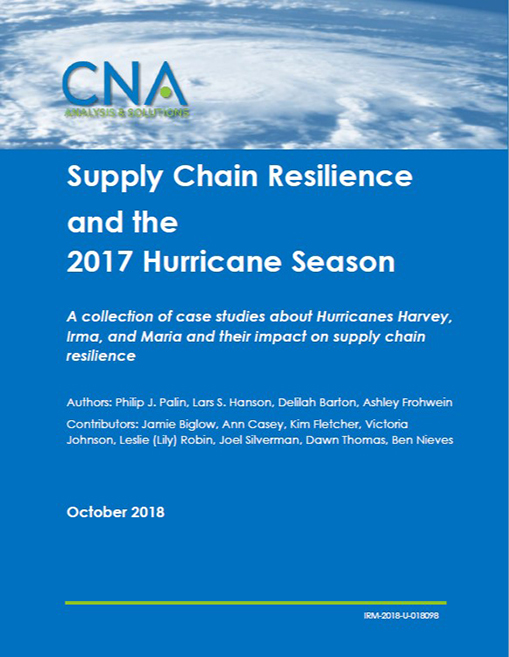A collection of case studies about Hurricanes Harvey, Irma, and Maria and their impact on supply chain resilience
Engaging Reality. Avoiding Catastrophe.
The 2017 Atlantic Hurricane Season demonstrated that when extreme events impact large, densely concentrated populations, survival is dependent on the ability to quickly reestablish and, as necessary, redirect preexisting demand and supply networks. This is especially true for critical lifeline supply chains such as fuel, water, and food. The more extreme the event, the more dense the population, and the more distant the location from sources of supply — the greater the dependence on the preexisting network for human survival.
Although the scope and scale of the 2017 Hurricane Season was in many ways extraordinary, this reality had already been revealed by prior disasters, including Hurricane Katrina, the 2011 Triple Disaster in Japan, and Superstorm Sandy. As this report was finalized, Hurricanes Lane and Florence provided further evidence. And yet, Harvey, Irma, and Maria — in what they share and how they differ — offer especially helpful lessons-to-be-learned.
Federal, state, and local government supplies for water, food, pharmaceuticals, medical goods, fuel, transportation assets, back-up power generations, emergency telecommunications and more can be crucial gap-fillers. But public sector emergency relief channels are simply incapable of fully replacing the existing networks.
Emergency management can aggravate or alleviate supply chain bottlenecks
The only sources of supply sufficient to fulfill “dense” demand — especially over an extended period — are those sources, systems, and networks (i.e., supply chains) that were operational the day before the extreme event. Moreover, federal, state, and local actions can unintentionally suppress recovery of these crucial capacities. They can also intentionally accelerate their restoration. Intentional acceleration is highly preferred.
Harvey, Irma, and Maria can teach us how demand and supply networks behave under duress, and how public and private entities can enhance shared understanding, reduce complications and act in concert to target needs and help speed restoration, redirection, and surge. They also illuminate opportunities for strategic interventions that can alleviate bottlenecks in private demand and supply networks, providing better outcomes for disaster survivors, speeding supply chain restoration, and reducing the demand for public relief supplies.
The report consists primarily of case studies. These are evidence-based stories that can advance our understanding of how complex adaptive systems of humans, infrastructure, information, and the natural world interact. There are positive cases where informed understanding of these interactions led to creative and effective interventions. But there are also examples from 2017 where misunderstanding pushed the entire system closer to catastrophe.
In an increasingly urbanized and interconnected world, learning and applying the lessons from 2017 will be critical to enhancing the resilience of lifeline supply chains, and the dense populations they support.
Download reportUnlimited distribution.
This work was performed under Subcontract Agreement No. 2000009358 to the National Academies of Sciences, Engineering, Medicine in completing Federal Government Contract No. HSHQDC-17A-B0001/70FB7018F00000167.
Details
- Pages: 164
- Document Number: IRM-108-U-018098
- Publication Date: 10/1/2018
